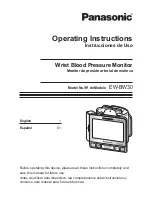
DN:KD-7961N-SMSY01 V3.0
Operation Guide
Template version:1
10/15
12. TECHNICAL ALARM DESCRIPTION
The monitor will show 'SYS HI','SYS Lo' ,'DIA HI' or 'DIA Lo' as technical alarm on LCD with no delay if the
determined blood pressure (systolic or diastolic) is outside the rated range specified in part SPECIFICACIONS.
In this case, you should consult a physician or check if your operation violated the instructions.
The technical alarm condition (outside the rated range) is preset in the factory and cannot be adjusted or
inactivated. This alarm condition is assigned as low priority according to IEC 60601-1-8.
The technical alarm is non-latching and need no reset. The signal displayed on LCD will disappear automatically
after about 8 seconds.
13.TROUBLESHOOTING (1)
PROBLEM
POSSIBLE CAUSE
SOLUTION
LCD
Display
shows
abnormal result
The cuff position was not correct or it
was not properly tightened
Apply the cuff correctly and try again
Body posture was not correct during
testing
Review
the
―BODY
POSTURE
DURING
MEASUREMENT‖ sections of the instructions and
re-test.
Speaking, arm or body movement,
angry, excited or nervous during testing
Re-test when calm and without speaking or moving
during the test
Irregular heartbeat (arrhythmia)
It is inappropriate for people with serious arrhythmia
to use this Electronic Sphygmomanometer.
14. TROUBLESHOOTING (2)
PROBLEM
POSSIBLE CAUSE
SOLUTION
LCD Display shows battery
symbol
Low Battery
Change the batteries
LCD Display shows
―EE‖
Arm or blood pressure monitor was
moved during testing
Re-test taking care to not move your arm or
the blood pressure monitor
The cuff does not inflate properly or
pressure falls quickly during testing
Make certain the plugs and brackets of the
cuff are securely attached to the monitor.
The cuff was not properly applied.
Apply the cuff correctly and try again
No response when you
press button or load battery.
Incorrect
operation
or
strong
electromagnetic interference.
Take out batteries for five minutes, and then
reinstall all batteries.
In Clock Mode, no response
when you press button.
The touch switch is in OFF position.
Please keep touch switch in ON position,
and try again

































